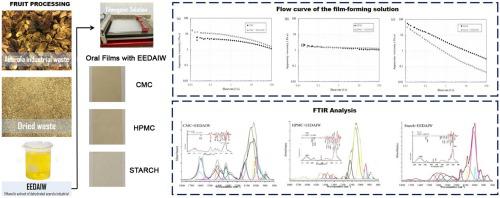Industrial Crops and Products ( IF 5.6 ) Pub Date : 2021-06-15 , DOI: 10.1016/j.indcrop.2021.113684 Marcela Perozzi Tedesco , Vitor Augusto dos Santos Garcia , Josiane Gonçalves Borges , Denise Osiro , Fernanda Maria Vanin , Cristiana Maria Pedroso Yoshida , Rosemary Aparecida de Carvalho

|
The residue from the processing of acerola, due to the concentration of active compounds, and antioxidant potential has aroused interest in its application. In this context, this study aimed to produce and characterization oral films based on carboxymethyl cellulose (CMC), hydroxypropyl methylcellulose (HPMC) and pre-gelatinized starch with the incorporation of ethanolic extract of dehydrated acerola industrial waste (EEDAIW) using tape-casting technique. The rheological properties of filmogenic solutions of CMC, HPMC, and starch were assessed. Oral films were characterized in relation to color parameters, mechanical properties, surface pH, contact angle, Fourier transform infrared (FTIR) spectroscopy, atomic force microscopy, and stability in relation to total phenolic compounds. It was found that apparent viscosity decreased with the deformation rate and the expected behavior of pseudoplastic fluids, regardless of the polymer used. In general, the addition of EEDAIW in the films led to a reduction in the tensile strength of the films and an increase in the contact angle values; however, the surface pH of the films remained close to the oral pH (6.8). From the FTIR, it was found that even after the addition of EEDAIW, all films showed predominant absorption bands, characteristic of the polymer used. It was found that after 84 days, CMC-based films had a higher concentration of total phenolic compounds when compared to HPMC and starch oral films.
中文翻译:

生产基于预糊化淀粉、CMC 和 HPMC 的口腔膜剂,用于输送从针叶樱桃工业废物中提取的生物活性化合物
由于活性化合物的浓度和抗氧化潜力,针叶樱桃加工过程中产生的残留物引起了人们对其应用的兴趣。在此背景下,本研究旨在使用流延技术生产和表征基于羧甲基纤维素 (CMC)、羟丙基甲基纤维素 (HPMC) 和预胶化淀粉的口腔薄膜,并掺入脱水针叶树工业废物 (EEDAIW) 的乙醇提取物. 评估了 CMC、HPMC 和淀粉的成膜溶液的流变特性。口腔膜的特征在于颜色参数、机械性能、表面 pH 值、接触角、傅里叶变换红外 (FTIR) 光谱、原子力显微镜以及与总酚类化合物相关的稳定性。发现表观粘度随变形速率和假塑性流体的预期行为而降低,而与使用的聚合物无关。一般来说,在薄膜中加入 EEDAIW 导致薄膜拉伸强度降低和接触角值增加;然而,薄膜的表面 pH 值仍然接近口腔 pH 值 (6.8)。从 FTIR 中发现,即使在添加 EEDAIW 之后,所有薄膜都显示出主要的吸收带,这是所用聚合物的特征。发现 84 天后,与 HPMC 和淀粉口腔膜相比,基于 CMC 的膜具有更高浓度的总酚类化合物。在薄膜中加入 EEDAIW 导致薄膜拉伸强度降低和接触角值增加;然而,薄膜的表面 pH 值仍然接近口腔 pH 值 (6.8)。从 FTIR 中发现,即使在添加 EEDAIW 之后,所有薄膜都显示出主要的吸收带,这是所用聚合物的特征。发现 84 天后,与 HPMC 和淀粉口腔膜相比,基于 CMC 的膜具有更高浓度的总酚类化合物。在薄膜中加入 EEDAIW 导致薄膜拉伸强度降低和接触角值增加;然而,薄膜的表面 pH 值仍然接近口腔 pH 值 (6.8)。从 FTIR 中发现,即使在添加 EEDAIW 之后,所有薄膜都显示出主要的吸收带,这是所用聚合物的特征。发现 84 天后,与 HPMC 和淀粉口腔膜相比,基于 CMC 的膜具有更高浓度的总酚类化合物。











































 京公网安备 11010802027423号
京公网安备 11010802027423号